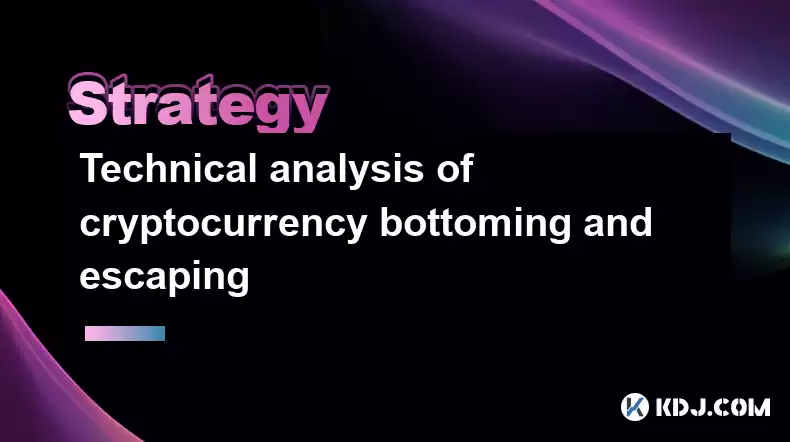-
 bitcoin
bitcoin $87959.907984 USD
1.34% -
 ethereum
ethereum $2920.497338 USD
3.04% -
 tether
tether $0.999775 USD
0.00% -
 xrp
xrp $2.237324 USD
8.12% -
 bnb
bnb $860.243768 USD
0.90% -
 solana
solana $138.089498 USD
5.43% -
 usd-coin
usd-coin $0.999807 USD
0.01% -
 tron
tron $0.272801 USD
-1.53% -
 dogecoin
dogecoin $0.150904 USD
2.96% -
 cardano
cardano $0.421635 USD
1.97% -
 hyperliquid
hyperliquid $32.152445 USD
2.23% -
 bitcoin-cash
bitcoin-cash $533.301069 USD
-1.94% -
 chainlink
chainlink $12.953417 USD
2.68% -
 unus-sed-leo
unus-sed-leo $9.535951 USD
0.73% -
 zcash
zcash $521.483386 USD
-2.87%
Technical analysis of cryptocurrency bottoming and escaping
Identifying crypto market bottoms is tricky; use multiple indicators like RSI, volume, and chart patterns to increase the probability of spotting a true bottom and escape.
Mar 30, 2025 at 03:14 pm

Identifying Cryptocurrency Bottoms
Pinpointing the exact bottom of a cryptocurrency market downturn is notoriously difficult. Technical analysis offers several tools to help identify potential bottom formations, but it's crucial to remember that these are probabilities, not certainties. No indicator is foolproof. Traders often combine several indicators for a more robust assessment.
One common approach involves studying price action on various timeframes. Looking at lower timeframes (e.g., hourly or daily charts) can help identify short-term support levels, while longer timeframes (weekly or monthly) provide context for the broader trend. A significant price bounce off a strong support level, coupled with increasing trading volume, could signal a potential bottom.
Another tool is the Relative Strength Index (RSI). The RSI is a momentum oscillator that measures the magnitude of recent price changes to evaluate overbought or oversold conditions. A reading below 30 often suggests an oversold market, potentially indicating a bottom is near. However, it’s crucial to note that the RSI can remain in oversold territory for extended periods.
Moving averages, such as the 200-day moving average, are frequently used to identify long-term trends. A price bounce off the 200-day moving average, especially with increasing volume, can be a bullish signal. However, it's not a guaranteed bottom signal; the price could still continue to decline.
Recognizing Escape Patterns
Once a potential bottom is identified, traders look for signs of an escape, indicating the price is breaking out of the downtrend. This often involves a decisive price move above a significant resistance level, coupled with increasing volume.
Several chart patterns can signal an escape. A head and shoulders reversal pattern is a bearish pattern that can indicate a potential bottom when the price breaks above the neckline. A double bottom pattern shows two consecutive lows, with a subsequent breakout above the resistance level. A cup and handle pattern, resembling a cup with a handle, can signal a bullish continuation after a period of consolidation. Remember, these patterns are most reliable when supported by other indicators.
Volume analysis is critical in confirming escape patterns. A significant increase in trading volume accompanying a price breakout above resistance is a strong bullish signal, suggesting a potential reversal of the downtrend. Conversely, a breakout with low volume might be a false signal, and the price could resume its downward trend.
Analyzing candlestick patterns can provide further insights into potential escape patterns. Bullish engulfing patterns, where a large green candlestick completely engulfs the preceding red candlestick, can indicate a shift in momentum. Similarly, hammer and morning star patterns are bullish reversal patterns that can signal a potential bottom and escape.
Using Indicators in Conjunction
It's essential to use multiple indicators and analysis methods to confirm potential bottom formations and escape patterns. Relying solely on one indicator can lead to inaccurate predictions and potentially significant losses.
For example, combining RSI with price action analysis provides a more comprehensive picture. A low RSI reading (oversold condition) combined with a price bounce off a strong support level with increasing volume significantly strengthens the possibility of a bottom.
Similarly, combining moving averages with candlestick patterns can improve the accuracy of identifying escape patterns. A price breakout above a significant moving average, confirmed by a bullish candlestick pattern and increasing volume, suggests a stronger potential for a successful escape.
Remember that even with multiple indicators, there's no guarantee of success. Market conditions can change rapidly, and unforeseen events can impact price movements. Therefore, risk management is crucial when trading cryptocurrencies.
Step-by-Step Guide to Identifying a Potential Bottom and Escape
Here's a step-by-step guide to help you identify potential bottom formations and escape patterns:
- Step 1: Analyze Price Action: Identify potential support levels on various timeframes. Look for price bounces off these support levels.
- Step 2: Observe Volume: Increased volume accompanying a price bounce strengthens the signal. Low volume suggests weakness.
- Step 3: Utilize RSI: Check if the RSI is below 30, indicating an oversold condition.
- Step 4: Examine Moving Averages: Observe price behavior relative to key moving averages (e.g., 200-day MA).
- Step 5: Identify Chart Patterns: Look for reversal patterns like head and shoulders, double bottoms, or cup and handle formations.
- Step 6: Analyze Candlestick Patterns: Identify bullish reversal patterns like engulfing patterns, hammers, or morning stars.
- Step 7: Confirm with Volume: Increased volume accompanying a breakout above resistance confirms the escape.
Frequently Asked Questions
Q: Are there any guaranteed methods to identify cryptocurrency bottoms?A: No, there are no guaranteed methods. Technical analysis provides probabilities, not certainties. Multiple indicators and careful risk management are essential.
Q: How reliable are chart patterns in predicting bottoms?A: Chart patterns are helpful but not foolproof. Their reliability increases when combined with other indicators like volume and RSI.
Q: What is the importance of volume in bottom and escape analysis?A: Volume confirms price action. High volume during a price bounce or breakout strengthens the signal, while low volume suggests weakness.
Q: Can RSI alone predict a bottom?A: No, RSI should be used in conjunction with other indicators. An oversold RSI (below 30) is a potential signal, but it's not definitive.
Q: How do I manage risk when trading based on bottom and escape analysis?A: Use stop-loss orders to limit potential losses. Diversify your portfolio and never invest more than you can afford to lose. Thorough research is crucial.
Q: What are some common mistakes traders make when identifying bottoms?A: Relying solely on one indicator, ignoring volume, misinterpreting chart patterns, and lacking risk management are common mistakes.
Q: What other factors beyond technical analysis should be considered?A: Fundamental analysis, news events, regulatory changes, and overall market sentiment can all significantly impact cryptocurrency prices. Consider these factors in your analysis.
Disclaimer:info@kdj.com
The information provided is not trading advice. kdj.com does not assume any responsibility for any investments made based on the information provided in this article. Cryptocurrencies are highly volatile and it is highly recommended that you invest with caution after thorough research!
If you believe that the content used on this website infringes your copyright, please contact us immediately (info@kdj.com) and we will delete it promptly.
- Cardano Price, ADA Pullback, and the Rise of Utility Networks: What's Next?
- 2025-12-07 05:45:01
- LILSHIB Who? Apeing & the Meme Coin Referral Rewards Revolution
- 2025-12-07 05:40:01
- Coinbase's Crypto Comeback Call: Is a December Recovery on the Horizon?
- 2025-12-07 20:05:01
- Bitcoin Price Wobbles: Crypto Market Eyes Recovery, Phong Lee Weighs In
- 2025-12-07 05:25:01
- Coins, Crypto, and Presales: What's Hot in the NYC Crypto Scene?
- 2025-12-07 18:25:01
- Altcoins on the Ropes: Declines and the Great Repricing of '25
- 2025-12-07 05:50:01
Related knowledge

Why My "Gut Feeling" About Crypto Is Always Wrong.
Dec 07,2025 at 07:00am
Emotional Triggers in Market Participation1. Fear of missing out (FOMO) drives impulsive buys during sharp price surges, often right before a correcti...

How to Build a Crypto Strategy That Works Even When You're Wrong.
Dec 07,2025 at 10:19am
Understanding Market Cycles1. Cryptocurrency markets operate in distinct phases: accumulation, markup, distribution, and markdown. These phases repeat...

How to Stop Treating Crypto Like a Casino and Start Building Wealth.
Dec 08,2025 at 02:00am
Understanding the Fundamentals1. Cryptocurrencies are not just speculative instruments—they represent protocols, networks, and economic systems with m...

The Fear of Missing Out (FOMO) vs. The Fear of Losing Everything (FUD): Which Is Worse?
Dec 09,2025 at 11:40am
FOMO in Cryptocurrency Markets1. FOMO emerges when traders observe rapid price surges in assets like Bitcoin or meme coins without participating in th...

"I Should Have Bought More": How to Deal with Post-Pump Regret.
Dec 07,2025 at 04:19pm
Understanding the Psychology Behind FOMO1. The human brain processes gains and losses asymmetrically, assigning greater emotional weight to missed opp...

My Friend Got Rich on a Shitcoin, Why Can't I? The Psychology of Gambling vs. Investing.
Dec 07,2025 at 01:39pm
The Illusion of Control in Volatile Markets1. Traders often misattribute random outcomes to skill, especially after witnessing a friend’s sudden gain ...

Why My "Gut Feeling" About Crypto Is Always Wrong.
Dec 07,2025 at 07:00am
Emotional Triggers in Market Participation1. Fear of missing out (FOMO) drives impulsive buys during sharp price surges, often right before a correcti...

How to Build a Crypto Strategy That Works Even When You're Wrong.
Dec 07,2025 at 10:19am
Understanding Market Cycles1. Cryptocurrency markets operate in distinct phases: accumulation, markup, distribution, and markdown. These phases repeat...

How to Stop Treating Crypto Like a Casino and Start Building Wealth.
Dec 08,2025 at 02:00am
Understanding the Fundamentals1. Cryptocurrencies are not just speculative instruments—they represent protocols, networks, and economic systems with m...

The Fear of Missing Out (FOMO) vs. The Fear of Losing Everything (FUD): Which Is Worse?
Dec 09,2025 at 11:40am
FOMO in Cryptocurrency Markets1. FOMO emerges when traders observe rapid price surges in assets like Bitcoin or meme coins without participating in th...

"I Should Have Bought More": How to Deal with Post-Pump Regret.
Dec 07,2025 at 04:19pm
Understanding the Psychology Behind FOMO1. The human brain processes gains and losses asymmetrically, assigning greater emotional weight to missed opp...

My Friend Got Rich on a Shitcoin, Why Can't I? The Psychology of Gambling vs. Investing.
Dec 07,2025 at 01:39pm
The Illusion of Control in Volatile Markets1. Traders often misattribute random outcomes to skill, especially after witnessing a friend’s sudden gain ...
See all articles










































































